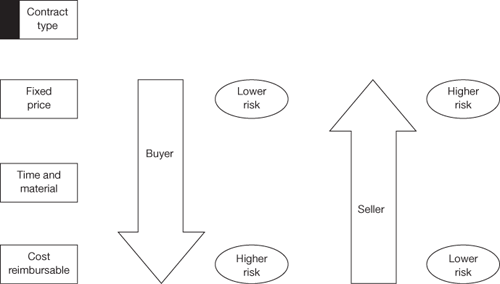Contracts
|
|
The point of selecting a seller is to contract with them. Project managers should understand the key features of the main types of contract. The three main types of contracts used are:
Fixed price (FP) contractsA fixed price contract involves agreeing a fixed total price for a specifically defined product or service to complete the described work. It is the most commonly used type of contract. The basic form of a fixed price contract is a purchase order that details the goods, what the price is and when it will be delivered. As the buyer, this form of contract has the lowest risk of increasing cost as long as the work has a fully defined scope to deliver against. If the seller signs a fixed price contract, the detail contained in the contract statement of work should be detailed and unambiguous to ensure higher costs are not borne by the seller. The advantage of using this type of contract is the reduced level of work required by the buyer to manage the contract. The buyer will know the price being charged and the incentive lies with the seller to control costs. Most companies have a lot of experience dealing with this type of contract, but extra work is required to produce the contract statement of work. A point to be monitored throughout the contract involves making sure the seller is completing all the work included within the contract statement of work. Another matter to review on a regular basis is the number of changes being incorporated in the contract, the effect of which could be the seller clawing back profit which may have been negotiated away in order to secure the contract. Cost reimbursable (CR) contractsFor a cost reimbursable contract, the cost risk shifts to the buyer because the total costs are unknown. The seller will bill for the actual costs incurred, plus an agreed fee or percentage of the total sum charged. This type of contract could be selected if the buyer is unable to define fully the scope of work, or the requirements are unknown. IT projects or R&D work can typically fall in this category of contract because their scope is not fully determined. A benefit for the buyer to select a CR contract is that less effort is involved in producing the contract statement of work because it is a simpler document. As stated earlier, the cost risk factor is lower for the seller, so the contract price can be lower compared to a FP contract for a similar package of work. The disadvantage associated with a CR contract is the greater level of management involvement required by the buyer, because extra auditing is required to ensure that invoices match the work and time expended. The other factor to be considered is the lack of incentive to control costs for the seller. Time and materials (T&M) contractsThe T&M type of contract can be considered an amalgamation of FP and CR. As an example, the rates quoted within the contract for material priced per metre are fixed for the duration of the contract, although the contract's total costs will rise if the amount of ordered material increases. This type of contract tends to be used for smaller contract amounts and spans a shorter time period. In comparison with the other two contract types, this approach has a medium risk to cost that sits between FP and CR. This type of contract is best considered for smaller projects. It is a good option when wishing to hire staff quickly to expand your team. The drawback of using a T&M contract is the requirement to provide the closest level of supervision. Figure 12.2 compares the risks to buyer and seller for the three types of contract.
Figure 12.2. Level of risk experienced by buyer and seller for different contract types
|
|
Top of Page

